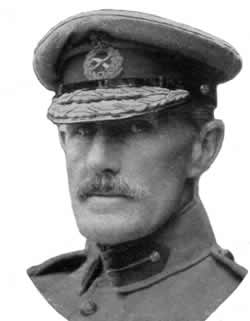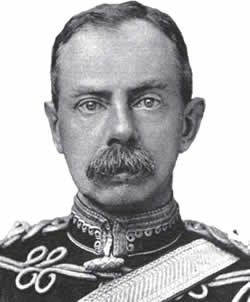 Order of Battle of the British Second Army: 22 April 1915
Order of Battle of the British Second Army: 22 April 1915
22 April 1915

|
Army Commander: General Sir Horace Smith-Dorrien (1858-1930)
Brigadier-General, General Staff: Brigadier-General G T Forestier-Walker
Headquarters: Hazebrouck, France
V. Corps
Commander: Lieutenant-General Sir Herbert C O Plumer (1857-1932)
Brigadier-General, General Staff: Brigadier-General H S Jeudwine
Headquarters: Poperinghe

|
The British front line on the Ypres Salient held by the V. Corps was nearly 18 kilometres in length. From north to south it ran from a point on the Ypres-Poelcappelle road, about a kilometre south of Poelcappelle village, through the western end of Broodseinde village, Polygon Wood, Herenthage Woods, through Shrewsbury Forest, and ended on the left of the British II. Corps, a few hundred metres north of Hill 60.
On the morning of 22 April there were three British divisions in the front line on the north-east and east of the Ypres Salient. From west to east and north to south around the Ypres Salient they were:
1st Canadian Division
Commander: Lieutenant-General E A H Alderson
Headquarters: Chateau des Trois Tours near Brielen
Front Line Position
The front line was held by four Canadian battalions:
3rd Canadian Infantry Brigade (Brigadier-General R E W Turner, V.C., HQ at Mouse Trap Farm)
- 13th Battalion (Royal Highlanders of Canada) under Lieutenant-Colonel F O W Loomis
- 15th Battalion (48th Highlanders of Canada) under Lieutenant-Colonel J A Currie.
2nd Canadian Infantry Brigade (Brigadier-General A W Currie, HQ at Pond Farm south-east of St. Julien)
- 5th Battalion (Western Cavalry) under Lieutenant-Colonel G S Tuxford and 8th Battalion (Winnepeg Rifles) under Lieutenant-Colonel L J Lipsett.
Second and Third Positions
Brigade Reserves:
- One battalion from 2nd Canadian Infantry Brigade at Wieltje: 7th Battalion (1st British Columbia Regiment) under Lieutenant-Colonel W F R Hart-McHarg.
- One battalion from 3rd Canadian Infantry Brigade at St. Jean: 14th Battalion (Royal Montreal Regiment) under Lieutenant-Colonel F S Meighen.
Divisional Reserves:
- One battalion from 2nd Canadian Infantry Brigade was located in the canal basin north east of Ypres: 10th Battalion (10th Canadians) under Lieutenant-Colonel R L Boyle.
- One battalion from 3rd Canadian Infantry Brigade was on the west bank of the Yser canal by a temporary bridge near Brielen: 16th Battalion (Canadian Scottish) under Lieutenant-Colonel R G E Leckie.
28th Division
Commander: Major-General E S Bulfin
Headquarters: Vlamertinghe chateau (moved there on 20 April after Ypres was shelled)
Front Line Position
The front line was held by eight battalions:
83rd Brigade (Brigadier-General R C Boyle, near railway line south-east of Frezenberg)
- 2nd Battalion The King's Own Regiment; 3rd Battalion The Monmouthshire Regiment; 1st Battalion The King's Own Yorkshire Light Infantry.
84th Brigade (Brigadier-General L J Bols, HQ east of Frezenberg village)
- 1st Battalion The Welsh Regiment; 12th Battalion The London Regiment (Rangers); 1st Battalion The Suffolk Regiment.
85th Brigade (Brigadier-General A J Chapman, HQ at Verlorenhoek)
- 3rd Battalion Royal Fusiliers; 2nd Battalion East Surrey Regiment.
Second and Third Positions
Brigade Reserves:
- One battalion from the 83rd Brigade was south-west of St. Jean: 5th Battalion the King's Own
- Two battalions from 84th Brigade were near Verlorenhoek: 2nd Battalion the Cheshire Regiment and 1st Battalion the Monmouthshire Regiment.
- Three battalions from 85th Brigade were west of St. Jean: 2nd Battalion East Kent Regiment (the Buffs) and the 3rd Battalion Middlesex Regiment. Half a battalion (i.e. two companies) of the 8th Middlesex Regiment were in support of the brigade on the Zonnebeke-Keerselaere road.
Divisional Reserves:
- Two battalions from the 83rd Brigade were west of Ypres, south of Brielen: 2nd Battalion East Yorkshire Regiment and the 1st Battalion York & Lancaster Regiment
- Half a battalion (i.e. two companies) from the 85th Brigade was at Vlamertinghe: 8th Battalion the Middlesex Regiment
27th Division
Commander: Major-General T D'O Snow
Headquarters: Potijze Chateau
Front Line Position
The front line was held by three battalions in each of the three brigades:
80th Brigade (Brigadier-General W E B Smith, HQ at Verlorenhoek)
- Princess Patricia's Canadian Light Infantry
- 3rd Battalion King's Royal Rifle Corps
- 4th Battalion King's Royal Rifle Corps
81st Brigade (Brigadier-General H L Croker, HQ north of the Menin Road at Hooge)
- 1st Battalion Argyll & Sutherland Highlanders
- 9th Battalion Argyll & Sutherland Highlanders
- 1st Battalion Royal Scots
82nd Brigade (Brigadier-General J R Longley, HQ south of the Menin Road at Hooge)
- 2nd Battalion Royal Irish Fusiliers
- 1st Battalion the Cambridgeshire Regiment
- 1st Battalion the Leinster Regiment
Second and Third Positions
Brigade Reserves:
- One battalion from the 80th Brigade was north of Bellewaerde Lake: 2nd Battalion King's Shropshire Light Infantry
- One battalion from the 81st Brigade was in the western end of Sanctuary Wood: 2nd Battalion the Gloucestershire Regiment
- One battalion from the 82nd Brigade was in the woods south of Zillebeke: 1st Battalion Royal Irish Regiment
Divisional Reserves:
- One battalion from the 80th Brigade was north-west of Ypres on the Ypres-Brielen road: 4th Battalion the Rifle Brigade
- One battalion from the 81st Brigade was south of Vlamertinghe: 9th Battalion Royal Scots
- One battalion from the 82nd Brigade was north-west of Ypres on the Ypres-Brielen road: 2nd Battalion Duke of Cornwall's Light Infantry
Army Reserve
As Second Army Reserves two brigades were located in the Vlamertinghe area:
- 1st Canadian Infantry Brigade (Brigadier-General M S Mercer)
- 13th Brigade (of II. Corps)
Canadian Field Artillery
Commander: Brigadier-General H E Burstall, CB (to 7.7.1915)
Two brigades of Canadian Field Artillery (C.F.A.) were situated in the second and third positions to support the Canadian Infantry Division.
- 2nd Brigade, C.F.A. (Lieutenant-Colonel C H MacLaren): 5th, 6th, 7th, 8th Batteries. Four 18 pounder guns per battery.
- 3rd Brigade, C.F.A. (Lieutenant-Colonel J H Mitchell): 9th, 10th, 11th, 12th Batteries. Four 18 pounder guns per battery.
One brigade was in reserve at Vlamertinghe:
- 1st Brigade, C.F.A. (Lieutenant-Colonel E W B Morrison, DSO): 1st, 2nd, 3rd, 4th Batteries. Four 18 pounder guns per battery.
Two 4.5 inch howitzer batteries of the Royal Field Artillery (R.F.A.) were supporting the 1st Canadian Division in positions east and south-east of St. Julien:
- 458 R.F.A.
- 459 R.F.A.
28th Division Field Artillery
18 pounder guns of the Royal Field Artillery (R.F.A.) supporting the 28th Division were:
- 18 R.F.A.
- 22 R.F.A.
- 62 R.F.A.
- 69 R.F.A.
- 100 R.F.A.
- 103 R.F.A.
- 149 R.F.A.
- 366 R.F.A.
- 367 R.F.A.
27th Division Field Artillery
18 pounder guns of the Royal Field Artillery (R.F.A.) supporting the 27th Division were:
- 11 R.F.A.
- 39 R.F.A.
- 67 R.F.A.
- 95 R.F.A.
- 96 R.F.A.
- 98 R.F.A.
- 99 R.F.A.
- 131 R.F.A.
- 132 R.F.A.
- 133 R.F.A.
- 148 R.F.A.
- 364 R.F.A.
Heavy Artillery
4.5 inch Howitzers supporting the 27th and 28th Divisions were:
- 37 R.F.A.
- 65 R.F.A.
- 61 R.F.A.
Heavy guns (4.7 inch batteries) supporting the V. Corps were :
- 2nd London Heavy Battery of XIII Brigade Royal Garrison Artillery in Kitchener's Wood
- 1st North Midland Heavy Battery of XIII Brigade Royal Garrison Artillery north of Wieltje
- 122nd Heavy Battery of XI. Brigade Royal Garrison Artillery near Frezenberg
- 123rd Heavy Battery south-east of Potijze
Royal Flying Corps
Of the three Wings serving with the British Army on the Western Front in early 1915 the 2nd Wing, Royal Flying Corps, was allotted to the Second British Army with Squadrons 1, 5 and 6.
- Artillery observation for V. Corps was carried out by Squadron No. 6.
- Strategic reconnaissance was carried out by the two squadrons with General Headquarters (Nos. 7 and 8)
- Bombing of railway stations and trains was carried out by the 2nd Wing with assistance from the 1st Wing (Nos. 2, 3 and 16 Squadrons allotted to the First British Army.
Defensive air patrols flew between 09.00 and 13.00 hours, and 17.00 to 18.00 hours.
Next>> German soldiers wait for the order to attack
Acknowledgements
British Military Operations: France and Belgium 1915
Official History of the Canadian Forces in The Great War 1914-1919, Volume I, Chronology, Appendices and Maps, Map 1
St. Julien (Battleground Europe Series)
GWPDA Photograph with grateful thanks to the Great War Primary Document Archive: Photos of the Great War.